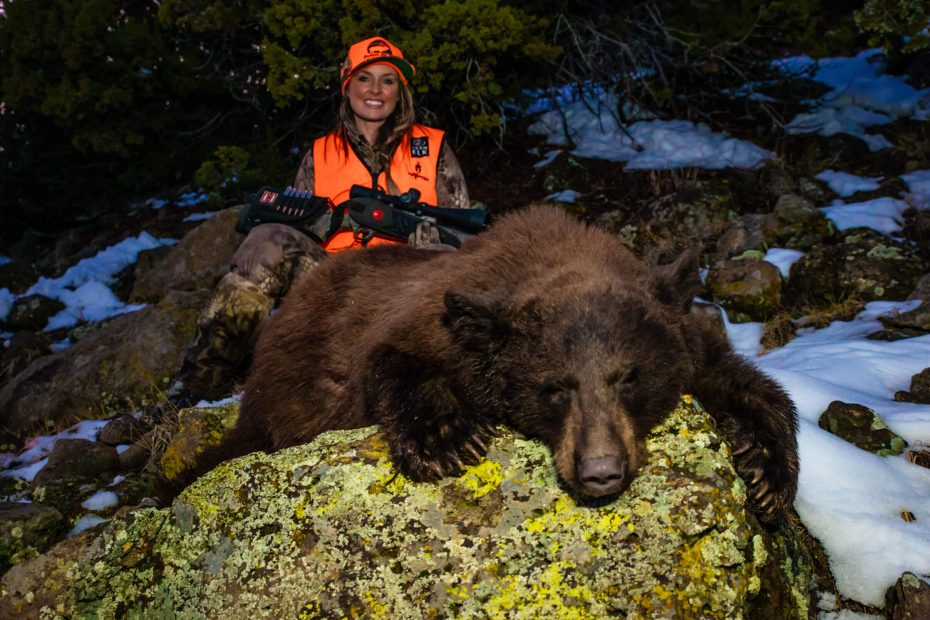
As we slowly emerge from the grip of Old Man Winter, many hunters welcome the beginnings of spring. The daylight hours are increasing, and the warm rays of sunshine greet the dandelion florets as they bloom yellow blossoms across the mountainside. These are the first signs that Mother Nature is prepared to welcome new life into the world. These are the days and months that are most critical to new life found in our elk and deer herds.
This is also the time that the black bear emerge from their den, ready to fill their bellies on wild onion, skunk cabbage, green grass shoots, and newly born calves and fawns. In many states, Wildlife Biologists have proven that black bear predation is the greatest factor in elk calf mortality rates.
Managing these large predators as part of the North American Model of Wildlife Conservation assists with increasing elk and deer survival rates during the critical period that makes up the first three months of life. It is also a valuable tool when it comes to relieving human and wildlife conflicts in certain geographical areas.
Find The Food Source Find The Bears

During spring spot and stalk black bear hunts you can expect to put on many miles while driving, hiking and glassing. The key to locating a spring black bear is covering miles targeting areas that are rich with succulent new vegetation. This can often be found on south-facing slopes, logging cut blocks, and river bottoms.
The Rut Is On
As the season progresses bears become increasingly nocturnal, however, you can find a feeding or cruising bear at any time during the day. Nonetheless, the golden hour for bear hunting still seems to be the last hour of daylight.
For bears, peak breeding occurs in the months of May and June. Boars will search day and night looking for a sow in heat, and a hot sow will often attract and concentrate several boars to an area. Keep in mind that a large boar will kill bear cubs in order to force a sow into estrous allowing the boar a rapid opportunity to breed.
Unique Hunting Experiences

Many western landscapes have intricate systems of gravel roads that can be used to access open areas that bears may feed. The pace on a spring black bear hunt will vary depending upon the hunter and the experience that they seek. Some hunters choose to cover seemingly endless miles from the seat of a pickup truck glassing cut-blocks while others that are physically able may choose to target vehicle road closures. Heading out afoot is a great way to hunt expansive areas with less human traffic. Locating fresh bear sign along a road closure provides an excellent opportunity to sit and glass.
Field Judging

Black bears are one of the most difficult animals to judge. When you spot a bear, the first evaluation is to determine if there are any cubs with the bear or nearby. Bear in mind, that you may spot multiple bears together, which could be a breeding pair and does not necessarily mean that it is a family unit consisting of a sow and cubs.
A few things to consider when evaluating a bear is that boars are often wider in the chest, tapering into the hindquarters. Sows tend to be wider in the hindquarters, tapering into the chest. Head and ears are another great way to evaluate the size of a bear. If the ears look large atop the head and have very little distance between them, it is most likely a smaller bear. Large bears tend to have bigger more square heads which make the ears appear to be smaller and/or have a larger distance between them.
The demeanor of a big old boar is typically more deliberate with slow and steady movements. He will appear as a confident animal that stands his ground and will be less inclined to be skittish or climb up a tree.
Looking at harvest photos from other successful hunters in the area can help you to determine the size and stature of bears and may prove to be quite helpful when field judging.
The Pursuit

Pursuing a bear can be anything from encountering them on a logging road to hiking into steep, rough terrain across a canyon. Bears are constantly on the move while feeding and sometimes, the bear will disappear before you ever get within range. However, if you find a big bear in a location with an abundant amount of forage, they will likely return to that area to feed.
Before you decide to press the trigger, evaluate the location of the bear and your physical ability. Hiking out of steep western landscapes with a pack full of bear meat, a heavy hide and skull can take numerous trips.
Hunting spring black bears is a great opportunity to actively manage large predators and provides the chance to enjoy long, relaxing days seeing beautiful terrain. As an added bonus, bear meat makes for a great addition to the freezer as a sustainably harvested protein resource.
